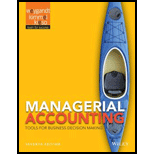
(a)
Direct Material cost:
Direct material cost is the cost of the material which is directly involved in the production. It constitutes the major portion of the total cost of the finished product. For example: The cost of plastic is the direct material for manufacturing a bottle.
To indicate: Whether the cost of a windshield would be classified as direct materials, direct labor, or manufacturing
(b)
Direct Material cost:
Direct material cost is the cost of the material which is directly involved in the production. It constitutes the major portion of the total cost of the finished product. For example: The cost of plastic is the direct material for manufacturing a bottle.
To indicate: Whether the cost of an engine would be classified as direct materials, direct labor, or manufacturing overhead.
(c)
Direct Labor Cost:
Direct labor cost is the cost of the labor paid to the employees who are directly involved in converting the raw materials to the finished products. It constitutes the major portion of the total cost of the finished product. For example: Wages paid to the mechanic for repairing an automobile.
To indicate: Whether the cost of the wages of the assembly line worker would be classified as direct materials, direct labor, or manufacturing overhead.
(d)
Factory overhead cost is the cost other than the direct material cost, and the direct labor cost which is not directly involved in the production process of converting the raw materials to the finished products. If the direct material cost or direct labor cost does not constitute the major portion of the total cost of the finished product, then it may be classified as the factory overhead cost. For example: Cost of repairing, and maintaining factory equipment.
To indicate: Whether the cost of the
(e)
Factory Overhead Cost:
Factory overhead cost is the cost other than the direct material cost, and the direct labor cost which is not directly involved in the production process of converting the raw materials to the finished products. If the direct material cost or direct labor cost does not constitute the major portion of the total cost of the finished product, then it may be classified as the factory overhead cost. For example: Cost of repairing, and maintaining factory equipment.
To indicate: Whether the cost of the factory machinery lubricants would be classified as direct materials, direct labor, or manufacturing overhead.
(f)
Direct Material cost:
Direct material cost is the cost of the material which is directly involved in the production. It constitutes the major portion of the total cost of the finished product. For example: The cost of plastic is the direct material for manufacturing a bottle.
To indicate: Whether the cost of the tires would be classified as direct materials, direct labor, or manufacturing overhead.
(g)
Direct Material cost:
Direct material cost is the cost of the material which is directly involved in the production. It constitutes the major portion of the total cost of the finished product. For example: The cost of plastic is the direct material for manufacturing a bottle.
To indicate: Whether the cost of the steering wheel would be classified as direct materials, direct labor, or manufacturing overhead.
(h)
Factory Overhead Cost:
Factory overhead cost is the cost other than the direct material cost, and the direct labor cost which is not directly involved in the production process of converting the raw materials to the finished products. If the direct material cost or direct labor cost does not constitute the major portion of the total cost of the finished product, then it may be classified as the factory overhead cost. For example: Cost of repairing, and maintaining factory equipment.
To indicate: Whether the salary of the painting supervisor would be classified as direct materials, direct labor, or manufacturing overhead.
Want to see the full answer?
Check out a sample textbook solution
Chapter 1 Solutions
Managerial Accounting: Tools for Business Decision Making 7e + WileyPLUS Registration Card
- Falcon Tech Co. manufactures and sells portable chargers. The company has annual fixed costs of $12,000,000. Each charger sells for $20 and incurs $11 in variable manufacturing costs. If the company’s total sales revenue last year was $45,000,000, how many chargers must Falcon Tech sell to achieve EBIT = 0?arrow_forwardGeneral accounting questionarrow_forwardNeed answerarrow_forward
- Nova Supplies Inc. offers credit terms of 3/15, net 50 to its customers. What is the nominal cost of trade credit if a customer forgoes the discount and pays on the 50th day? (Assume 365 days in a year.)arrow_forwardPlease solve this question General accounting and step by step explanationarrow_forwardCan you solve this general accounting problem using accurate calculation methods?arrow_forward
- Principles of Accounting Volume 2AccountingISBN:9781947172609Author:OpenStaxPublisher:OpenStax College
 Managerial AccountingAccountingISBN:9781337912020Author:Carl Warren, Ph.d. Cma William B. TaylerPublisher:South-Western College Pub
Managerial AccountingAccountingISBN:9781337912020Author:Carl Warren, Ph.d. Cma William B. TaylerPublisher:South-Western College Pub

